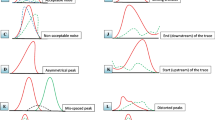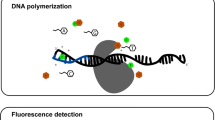Abstract
Objectives
The objectives of this paper are to determine the storage stability of saliva at 37 °C over an 18-month period, and its influence on the DNA yield, purity, PCR protocols and genotyping efficacy.
Materials and methods
Of the 60 participants, blood samples were obtained from 10 and saliva from 50. Samples were subjected to different storage conditions: DNA extracted immediately; DNA extracted following storage at 37 °C for 1, 6, 12 and 18 months. Subsequently, DNA yield, OD260/280 and OD260/230 ratios were measured. The isolated DNA was used to amplify exons 0–7 of the RUNX2 gene and subsequently sequenced. Furthermore, 25 SNPs were genotyped.
Results
The mean DNA yield, OD260/280 and OD260/230 ratios obtained from blood were 67.4 ng/μl, 1.8 ± 0.05 and 1.8 ± 0.4 respectively. DNA yield obtained from saliva was significantly higher than blood (p < 0.0001), ranging from 97.4 to 125.8 ng/μl while the OD260/280 ratio ranged from 1.8 ± 0.13 to 1.9 ± 0.1. The success rates for the 25 SNPs ranged from 98 to 100 % for blood and 96–99 % for saliva samples with the genotype frequencies in Hardy–Weinberg equilibrium (>0.01).
Conclusions
Saliva can be stored at 37 °C for 18 months without compromising its quality and ability to endure genetic analyses.
Clinical relevance
Saliva is a viable source of human DNA to facilitate the feasibility of large-scale genetic studies.


Similar content being viewed by others
References
Ng DP, Koh D, Choo S, Chia KS (2006) Saliva as a viable alternative source of human genomic DNA in genetic epidemiology. Clin Chim Acta 367:81–85
Ng DP, Koh D, Choo S, Ng V, Fu QY (2004) Effect of storage conditions on the extraction of PCR-quality genomic DNA from saliva. Clin Chim Acta 343:191–194
Quinque D, Kittler R, Kayser M, Stoneking M, Nasidze I (2006) Evaluation of saliva as a source of human DNA for population and association studies. Anal Biochem 353:272–277
Rogers NL, Cole SA, Lan HC, Crossa A, Demerath EW (2007) New saliva DNA collection method compared to buccal cell collection techniques for epidemiological studies. Am J Hum Biol 19:319–326
Mulot C, Stücker I, Clavel J, Beaune P, Loriot MA (2005) Collection of human genomic DNA from buccal cells for genetics studies: comparison between cytobrush, mouthwash, and treated card. J Biomed Biotechnol 3:291–296
García-Closas M, Egan KM, Abruzzo J, Newcomb PA, Titus-Ernstoff L, Franklin T et al (2001) Collection of genomic DNA from adults in epidemiological studies by buccal cytobrush and mouthwash. Cancer Epidemiol Biomarkers Prev 6:687–696
Cozier YC, Palmer JR, Rosenberg L (2004) Comparison of methods for collection of DNA samples by mail in the Black Women’s Health Study. Ann Epidemiol 2:117–122
Luan JA, Wong MY, Day NE, Wareham NJ (2001) Sample size determination for studies of gene–environment interaction. Int J Epidemiol 30:1035–1040
Holland NT, Smith MT, Eskenazi B, Bastaki M (2003) Biological sample collection and processing for molecular epidemiological studies. Mutat Res 543:217–234
Xuan D, Li S, Zhang X, Hu F, Lin L, Wang C et al (2008) Mutations in the RUNX2 gene in Chinese patients with cleidocranial dysplasia. Ann Clin Lab Sci 38:15–24
Phillips MS, Lawrence R, Sachidanandam R, Morris AP, Balding DJ, Donaldson MA et al (2003) Chromosome-wide distribution of haplotype blocks and the role of recombination hot spots. Nat Genet 33:382–387
Halsall A, Ravetto P, Reyes Y, Thelwell N, Davidson A, Gaut R et al (2008) The quality of DNA extracted from liquid or dried blood is not adversely affected by storage at 4 degrees C for up to 24 h. Int J Epidemiol 37(Suppl 1):i7–i10
Visvikis S, Schlenck A, Maurice M (1998) DNA extraction and stability of epidemiological studies. Clin Chem Lab Med 36:551–555
Dawes C (2003) Estimates, from salivary analyses, of the turnover time of the oral mucosal epithelium in humans and the number of bacteria in an edentulous mouth. Arch Oral Biol 48:329–336
Halsall A, Ravetto P, Reyes Y, Thelwell N, Davidson A, Gaut R et al (2008) The quality of DNA extracted from liquid or dried blood is not adversely affected by storage at 4 degrees C for up to 24 h. Int J Epidemiol 37:7–10
Rylander-Rudqvist T, Håkansson N, Tybring G, Wolk A (2006) Quality and quantity of saliva DNA obtained from the self-administrated oragene method—a pilot study on the cohort of Swedish men. Cancer Epidemiol Biomarkers Prev 15:1742–1745
Chartier J, Birnboim H (2004) Bacterial DNA content with OrageneTM. DNA Genotek, Ottawa
van Schie RC, Wilson ME (1997) Saliva: a convenient source of DNA for analysis of bi-allelic polymorphisms of Fc gamma receptor IIA (CD32) and Fc gamma receptor IIIB (CD16). J Immunol Methods 208:91–101
Andrisin TE, Humma LM, Johnson JA (2002) Collection of genomic DNA by the non-invasive mouthwash method for use in pharmacogenetic studies. Pharmacotherapy 22:954–960
Acknowledgments
We thank the participants for their cooperation. This work was supported by the department fund (Paediatric Dentistry and Orthodontics, The University of Hong Kong).
Conflict of interest
The author(s) declare no potential conflicts of interest with respect to the authorship and/or publication of this article.
Author information
Authors and Affiliations
Corresponding author
Rights and permissions
About this article
Cite this article
Anthonappa, R.P., King, N.M. & Rabie, A.B.M. Evaluation of the long-term storage stability of saliva as a source of human DNA. Clin Oral Invest 17, 1719–1725 (2013). https://doi.org/10.1007/s00784-012-0871-5
Received:
Accepted:
Published:
Issue Date:
DOI: https://doi.org/10.1007/s00784-012-0871-5




